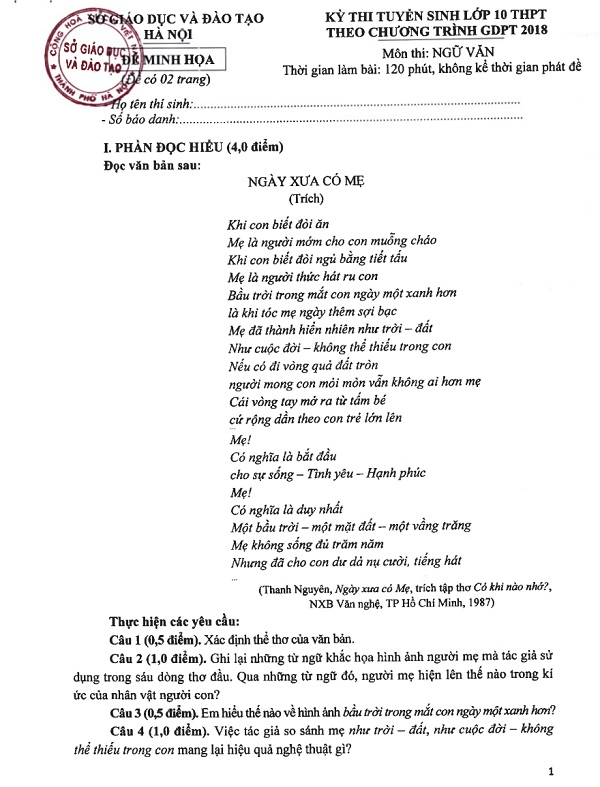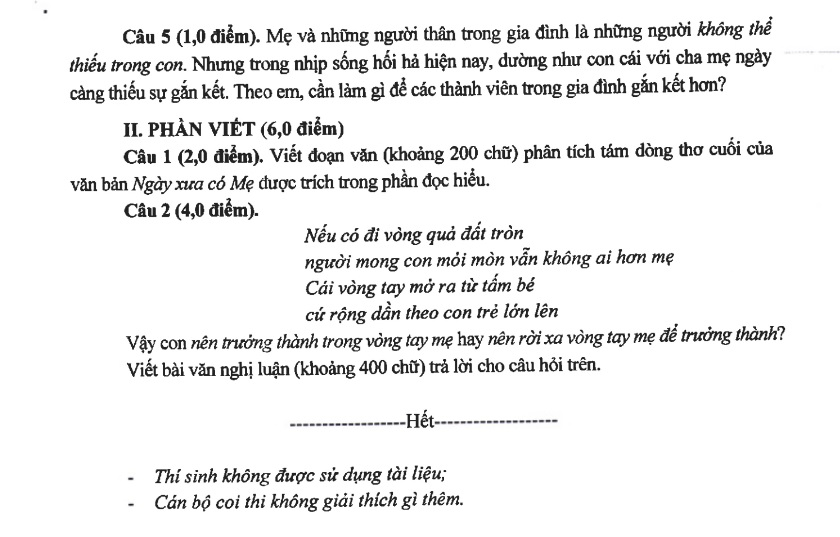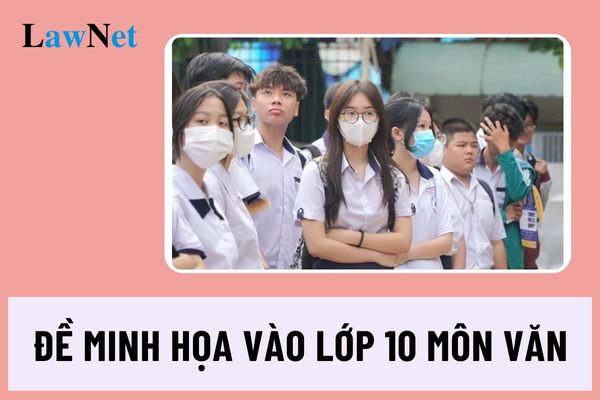Sample Exam for Grade 10 Literature in 2025 in Hanoi According to the 2018 General Education Program with Answers
Sample Exam for Grade 10 Literature in 2025 in Hanoi According to the 2018 General Education Program with Answers
On April 29, 2024, the Hanoi Department of Education and Training announced the format structure and sample exam for public high school admissions in 2025, constructed according to the 2018 General Education Program in Notification 2988/TB-SGDDT in 2024.
>> Download Notification 2988/TB-SGDDT in 2024.
The sample exam for 10th grade Literature 2025 in Hanoi is as follows:


Suggested Answers for the 2025 10th Grade Literature Sample Exam in Hanoi:
| Part I. Reading Comprehension Question 1. Method: Based on the types of poetry learned. Explanation: - Free verse. Question 2. Method: Based on the reading comprehension content, find the ideas. Explanation: - The first stanza depicts the mother: feeding the child a spoon of porridge, staying awake to lull the child to sleep, and her hair becoming grayer. - These phrases portray the mother as hardworking, caring for the child's every meal and sleep. The mother is a companion through the child's life from infancy to adulthood. Question 3. Method: Based on the reading comprehension content, analyze. Explanation: “The sky” here can be understood as the vast world out there waiting for the child to explore. Through each spoon of porridge and lullaby from the mother, the child grows and matures. The sky will "become bluer" as the child grows up, leaving the mother's loving embrace to write new chapters of life and explore the vast, wide world. Question 4. Method: Analyze. Explanation: The comparison of the mother to the sky - earth, like life - indispensable in oneself brings out artistic effectiveness: - Firstly, it makes the poem more lively and attractive. - Additionally, the comparison highlights the significant and irreplaceable role of the mother in the child's life: “sky - earth”: evokes the vastness, immensity, and permanence like the mother's love always present and covering the child. “like life - indispensable in oneself”: emphasizes the importance of the mother, tied to the life, soul, and existence of the child. - Through this comparison, the author emphasizes the mother's importance to everyone. From there, acknowledges and praises the mother's role and significance to all of us. Question 5. Method: Analyze. Explanation: Things to do to bond family members: - Regularly share, talk about work, study, emotions, and life's pressures… - Help, support, and encourage each other. - Maintain family traditions. - Respect and accept the differences of family members. - Share responsibilities in common tasks together. - Show love and affection to family members. - Resolve conflicts in a civilized and constructive manner. - … Part II. Essay Question 1. Method: Analyze, aggregate. Explanation: The essay can be developed in various ways, below is a suggestion from the Tuyensinh247.com expert team General requirements: - A social argumentative paragraph of about 200 words, complete with an introduction, body, and conclusion. - Analysis content of the last eight lines in the reading comprehension. Specific requirements: 1. Introduction: Briefly introduce the author, the work, and the excerpt's content. 2. Body: - The first six lines: The author skillfully uses stylistic devices: + Use of special sentence: “Mother!” This line defines and affirms the significant role of the mother in each person's life. The sacred, noble call expresses the love and tenderness of the grown-up child from the mother's loving arms. + Flexible use of stylistic devices: repetition (Meaning is…), enumeration... + The tone of the poem is both affirming and emotive, affectionate… => The author affirms: The mother is the source of life, love, and happiness, and she is unique in everyone's life. - Mother not living a full hundred years: suggests the human existence rule: the mother cannot live her entire life with the child, she will age as the child matures, but she has given the child life, smiles, songs, and beliefs... => The gratitude of the child towards the mother, the love, and happiness of having a mother. 3. Conclusion: Free verse form with flexible rhyme and rhythm, interspersed with long and short lines, an array of diverse stylistic devices, a sentimental, expressive tone… helps the reader better understand the role, immense contributions of the mother… It also expresses the child’s gratitude and appreciation for the mother. Question 2. Method: Analyze, aggregate. Explanation: The essay can be developed in various ways, below is a suggestion from the Tuyensinh247.com expert team 1. Introduction: Briefly introduce the discussion topic “Should one grow up in the mother’s embrace or step out of the embrace to mature?” 2. Body: a. Explanation: - Summarize the content of the excerpt: The excerpt talks about the mother’s love and care for the child. No matter where the child is, the mother always loves unconditionally. The mother accompanies the child from childhood to later stages. - Maturity: the completeness in both physical and spiritual aspects. The ability to solve problems independently without relying on others. - Mother’s embrace: Represents love, care, help. Protection and support. b. Discussion. Students should present their own choice, with appropriate reasoning. Below is a suggestion: - Stepping out of the mother’s embrace means facing challenges and difficulties independently. It leads to self-reliance and maturity. + Learning to solve problems independently, gaining new knowledge, acquiring essential life experiences. + Learning to balance personal emotions, developing patience, responsibility, empathy, and sharing. + Discovering hidden potentials. - Nonetheless, the role of the “mother’s embrace” in one’s maturity cannot be denied. The family is always a place to return to, and the parents’ embrace is a pillar during failures. It serves as an invaluable motivation for resilience and continued growth. Students should provide suitable examples. c. Comment - Continuously strive, solve life’s problems independently. Regardless of maturing within or outside the mother’s embrace, this environment nurtures growth. - Always cherish, appreciate, and love parents; family affection is the foundation of personal growth. - Criticize those who habitually rely entirely on parents. 3. Conclusion: Summarize the discussion. |
Note: The answers above are for reference purposes only.

Sample Exam for Grade 10 Literature in 2025 in Hanoi According to the 2018 General Education Program with Answers (Image from the Internet)
What is the Time Allocation for the 2018 General Education Program for Grade 10 Literature in Vietnam?
Based on the General Education Curriculum for Literature issued with Circular 32/2018/TT-BGDDT, the time allocation for implementing the program is as follows:
- Implementation time by class (by number of lessons)
| Grade 1 | Grade 2 | Grade 3 | Grade 4 | Grade 5 | Grade 6 | Grade 7 | Grade 8 | Grade 9 | Grade 10 | Grade 11 | Grade 12 |
| 420 | 350 | 245 | 245 | 245 | 140 | 140 | 140 | 140 | 105 | 105 | 105 |
In high school, each grade has an additional 35 lessons for elective study topics.
- Time allocation for educational content:
The time for educational content is arranged by the textbook authors and teachers based on the required achievements for each grade and the actual teaching situation. However, it’s necessary to ensure a reasonable balance between the following components:
+ Between knowledge acquisition and skill training (focusing on practical skill training and application).
+ Between different types and genres of texts in reading, writing, speaking, and listening (allocating more time for reading literary texts).
+ Between reading, writing, speaking, and listening skills (allocating more time for reading skill practice); specifically, the time distribution for each skill by grade is as follows:
| Grade Group | Reading | Writing | Speaking and Listening | Periodic Assessment |
| From Grade 1 to Grade 3 | about 60% | about 25% | about 10% | about 5% |
| From Grade 4 to Grade 5 | about 63% | about 22% | about 10% | about 5% |
| From Grade 6 to Grade 9 | about 63% | about 22% | about 10% | about 5% |
| From Grade 10 to Grade 12 | about 60% | about 25% | about 10% | about 5% |
Thus, 10th graders studying the 2018 General Education Program for Literature have 105 lessons, with about 60% of the content being reading, about 25% writing, about 10% speaking and listening, and the remaining 5% for periodic assessments.
What Literary Knowledge Should 10th Graders in Vietnam Have?
Also, in sub-section 2 Section 5 of the General Education Curriculum for Literature issued with Circular 32/2018/TT-BGDDT, the literary knowledge for 10th grade students includes:
- The main inspiration of the work
- The story, the third-person omniscient narrator, the first-person limited narrator, the viewpoint in the story
- Some elements of epic and mythology: space, time, plot, narrator, characters, narrator's words and characters' words, etc.; the value and vitality of the epic
- Aesthetic value of some formal elements in poetry
- Some elements of an opera or folk play script: anonymity, theme, plot, characters, dialogues, modes of transmission, etc.
- The historical, cultural, or social backdrop and the work
- Basic knowledge about Nguyen Trai to help in understanding some representative works of this author
- The thematic proximity of literary works from different cultural backgrounds
- Literary works and the reader

